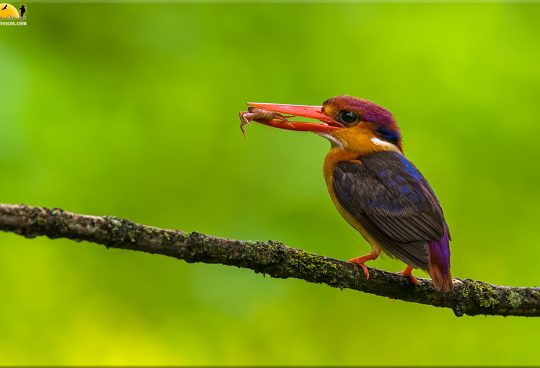Great Hornbills also known as the great Indian hornbill or great pied hornbill, is one of the larger members of the hornbill family. They are the largest hornbills in India (112-150 cm), males: 2.6 to 3.9 kg; females: 2.16 – 3.35 kg. It has a white tail with a horizontal black band, white neck and wing bars, wing edges are white-tipped. Eye colour: males: red, with black skin; females: white eyes with red skin around the eyes. The yellow beak is topped by a casque. The male has a flat casque forked in front and edged with black; the female’s casque is smaller with no black. The white plumage on the head, neck, wing coverts and tail base are often stained yellow with oil from the preen gland. It flies with heavy wing beats, a few flaps and a long glide. The most prominent feature of the hornbill is the bright yellow and black casque on top of its massive bill. The casque appears U-shaped when viewed from the front, and the top is concave, with two ridges along the sides that form points in the front, whence the Latin species epithet bicornis (two-horned). The back of the casque is reddish in females, while the underside of the front and back of the casque is black in males
Great hornbills are found in the forests of India, Bhutan, Nepal, Mainland Southeast Asia, Indonesian Island of Sumatra and North eastern region of India. The distribution of the species is fragmented over its range in the Indian subcontinent and Southeast Asia. In the subcontinent they are found in a few forest areas in the Western Ghats and in the forests along the Himalayas. Great hornbills are usually seen in small parties, with larger groups sometimes aggregating at fruit trees. A congregation of 150 to 200 birds has been recorded in southeastern Bhutan. In the wild, the great hornbill’s diet consists mainly of fruit. Figs are particularly important as a food source. Due to habitat loss and hunting in some areas, the great hornbill is evaluated as vulnerable on the IUCN Red List of Threatened Species.
![]()






Sorry, the comment form is closed at this time.